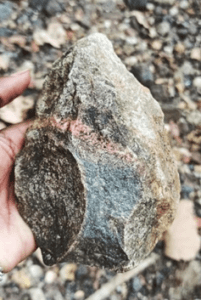TAG: GS 1: ART AND CULTURE
THE CONTEXT: The recent floods in the Mulugu district of Telangana has led to a fresh discovery of paleolithic quartzite tools.
EXPLANATION:
- In the aftermath of the floods that ravaged Mulugu district in Telangana, a significant discovery of Paleolithic quartzite tools has been made.
- Sriramoju Haragopal, leading a team of amateur historians, reported the discovery of these tools in the dried-up bed of a stream that emerged after the floodwaters receded.
- This unexpected exposure of the tools unveiled vital archaeological artifacts.
- The hand axes were specifically unearthed in the stream between Gurrevula and Bhupatipuram villages in Mulugu district.
- A researcher, discovered a stone axe measuring 15.5cm in length, 11cm in width, and 5.5cm in thickness, further solidifying the historical significance of the findings.

Historical Context and Significance
- Paleontologist sheds light on the historical period to which the stone axe belongs, identifying it as part of the Lower Paleolithic period, dating back approximately 30 lakh (3 million) years ago.
- This period corresponds to the Early Stone Age, also known as the Old Stone Age, and spans around 33 lakh (3.3 million) years BC, persisting for about 10,000 years.
- The identification of these tools is based on various characteristics, including chipping style, material, and size.
- The heavy quartzite material and the large size of these tools align with the typical implements used by Paleolithic hunter-gatherers.
- Such hand axes, globally discovered, were primarily utilized for activities such as cutting wood and hunting animals for sustenance.
Comparative Analysis with Previous Discoveries
- This discovery in Telangana augments the understanding of human settlements in the region and central India, significantly pushing back the timeline.
- Reference is made to the Paleolithic site at Attirampakkam near Madras (Chennai), where bifacial hand axes made of stone by early humans were found in 1863.
- These tools, estimated to be about 15 lakh (1.5 million) years old, are attributed to the Madras Hand-Axe Industry or Madrasian Culture.
Implications and Contributions to Archaeology
- The discovery in Mulugu district holds immense significance in expanding the historical narrative of human habitation in Telangana and central India.
- Understanding the tools used by early humans provides insights into their lifestyles, including hunting practices and tool-making technologies.
- Moreover, the comparative analysis with similar discoveries worldwide offers valuable connections in the study of human evolution and cultural development during the Paleolithic era.
- This finding adds to the growing body of evidence shedding light on ancient human settlements.
- It enriches our understanding of prehistoric communities and their interactions with the environment, tools, and resources available during that epoch.

